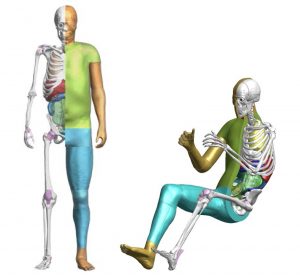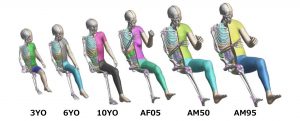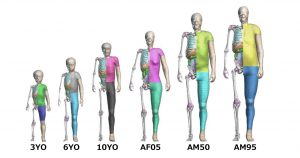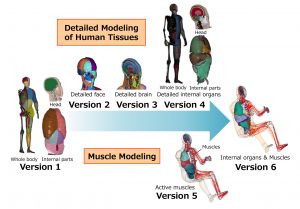Toyota Puts Safety First with Free Access to its Human Crash Test Modelling Software
Toyota is to give free access to its world-first THUMS virtual human modelling system, a software programme for computer simulation and analysis of the injuries sustained in different types of vehicle collisions. In its mission to help build a safe mobility society, it hopes others will use THUMS – Total Human Model for Safety – to design safer cars, systems and equipment.
THUMS was developed in co-operation with Toyota Central R&D Labs and launched in 2000. Since then this “virtual crash test dummy” software has progressed through six versions, each providing increasingly sophisticated modelling. Today, it can replicate the effects of an impact on the skeleton, internal organs and muscle tissue of different genders, age groups and physiques.
Compared to the physical crash test dummies commonly used in vehicle collision tests, THUMS allows injuries to be analysed in much greater detail, because it precisely models the shape and durability of different human body types. Using a software programme also allows repeated analysis of different collision patterns and can dramatically reduce testing costs and development lead times.
THUMS evolution
More than 100 vehicle manufacturers, suppliers, academic bodies, research organisations and others are already using THUMS, both in Japan and around the world. It is being applied in the research and development of many different safety technologies, including seatbelts, airbags and vehicle structures that can reduce the risk of pedestrian injuries. Vehicle safety assessment organisations are also considering using the software for future virtual testing.
By making THUMS freely available from January 2021, Toyota hopes that not only more people will use it in their safety research, but also that the software’s usability will be enhanced, as further improvements are made and shared with others.
Seigo Kuzumaki, a Fellow at Advanced R&D and Engineering, said: “Since THUMS was launched, we’ve been making improvements and working hard to better reproduce the human anatomy and expand the variations in our models. It has become indispensable to Toyota’s efforts to develop safety technologies and vehicles. We decided to make the software freely available so that more people can use it and further improve vehicle safety across the entire automotive industry. This should help reduce traffic injuries and fatalities, creating a safer society.”
THUMS software licence sales through the JSOL Corporation in Tokyo and the ESI Group in Paris will come to an end during 2020, prior to the start of free access.
THUMS history timeline
| YEAR | PROGRESS | DETAILS |
| 1997 | Toyota begins development of THUMS with Toyota Central R&D Labs | |
| 2000 | Version 1 released | Detailed modelling of bones added |
| 2005 | Version 2 released | Detailed modelling of faces added |
| 2008 | Version 3 released | Detailed brain modelling added |
| 2010 | Version 4 released | Detailed modelling of internal organs |
| 2011 | Different physiques added to Version 4 | Small female and large male models added |
| 2015 | Version 5 released | Modelling of all body muscles added |
| 2016 | Child models added to Version 4 | Child models aged 3, 6 and 10 years old |
| 2019 | Version 6 released | Muscles added to internal organ modelling |
| 2020 | Announcement of free access from January 2021 | Current release |
ENDS





